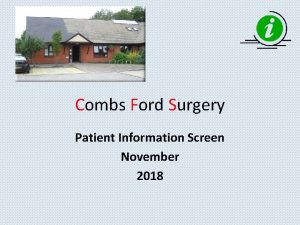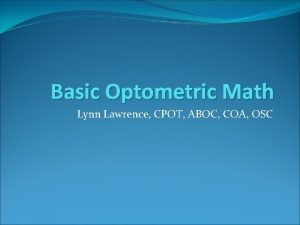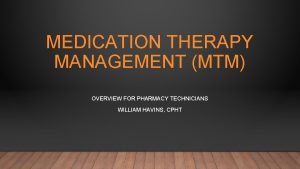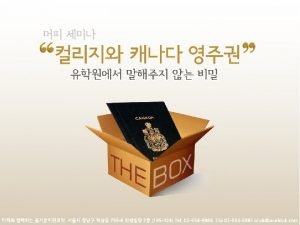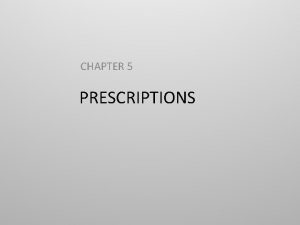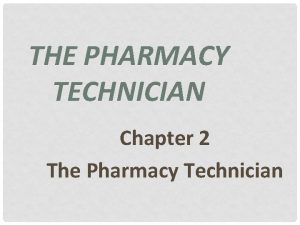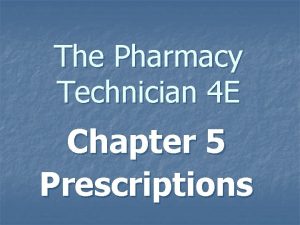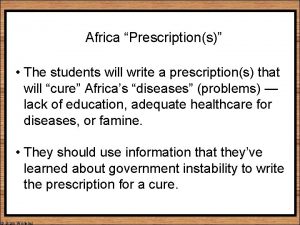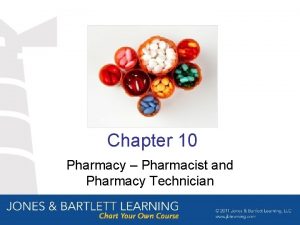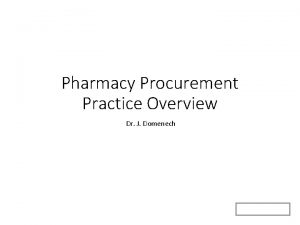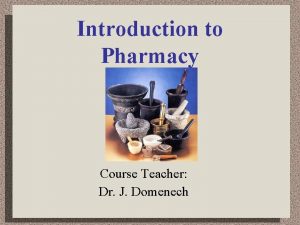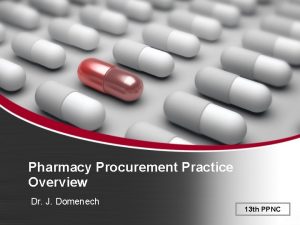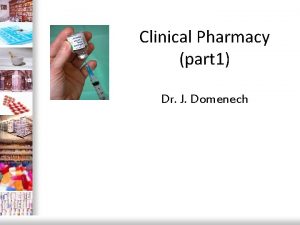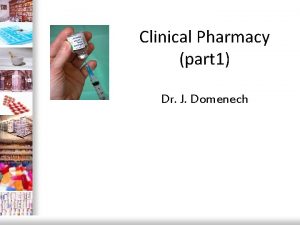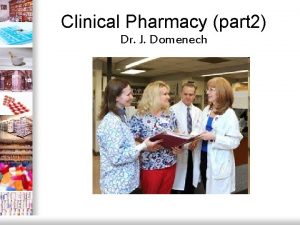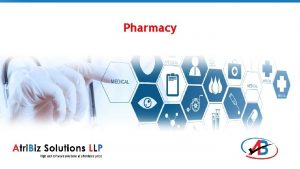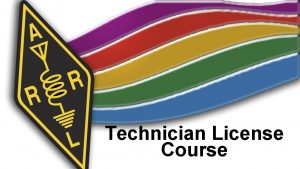The Pharmacy Technician Dr J Domenech Prescriptions Chapter








































- Slides: 40

The Pharmacy Technician Dr. J. Domenech Prescriptions

Chapter Outline • Prescriptions • Pharmacy Abbreviations • Prescription Information • The Fill Process • Labels • HIPPA

Prescriptions are a written order from a practitioner for the preparation and administration of a medicine or a device. Unrestricted n Medical Doctors (MD) n Doctors of Osteopathy (DO) Limited to some States • Nurse Practitioners • Physician assistance In their field of practice • Dentists (DDS) • Veterinarians (DVM) • Podiatrists – their field of practice • Opticians Based on protocols • Pharmacists

Dispensing Prescriptions n n Community Pharmacists n Dispense directly to the patient. n The patient is expected to administer the medication according to the pharmacist direction. Institutional Pharmacy n Nursing staff generally get the medications mostly from the pharmacists and administers to patients.

The Prescription Process 1. A prescription is written by a prescriber. 2. The patient drops off the prescription.

The Prescription Process 3. The pharmacy technician checks the prescription to make certain it is complete and authentic. n Verify that the patient is in the pharmacy database. n If the patient is not in the pharmacy database, the technician obtains necessary demographic, insurance, and allergy information from the patient. n Enters the information into the computer.

Guidelines For Receiving And Reviewing Prescriptions 4. Checking for completeness of each part of a prescription include: 1. prescriber information, 2. the date, 3. patient information, 4. the symbol Rx, 5. the inscription, 6. the subscription, 7. the signa, 8. additional instructions, and 9. the signature.

The Prescription Process 5. The pharmacy technician enters the prescription into the computer and the insurance and billing information is processed. n n Bills the insurance company or the patient. The computer system evaluates the data against stored information and process any third party billing online. The pharmacy technician asks the pharmacist to check the drug use review (DUR) or drug interaction that might be generated. If claims rejected, review the data and resubmit claim.

The Prescription Process 6. Label is generated. n Once the payment is approved by the third party, a label that contains copayment is printed.

The Prescription Process 7. Prescription is prepared. n The pharmacy technician selects the appropriate medication and verifies the National Drug Code (NDC) number on the computer-generated medication label. n Prepares the medication(s). n E. g. , the prescribed number of tablets is counted or the liquid measured. . n Packages the medication in the appropriate container. n Labels the prescription container with the computergenerated medication label. In some states the law requires the pharmacist to affix the label to the container.

The Prescription Process 8. The pharmacy technician prepares the filled prescription for the pharmacist to check. n THE PHARMACIST CHECKS the prescription(s) and may initial it. n The pharmacy technician bags the approved prescription for patient sale and attaches an information sheet about the prescription, including indications, interactions, and possible side effects.

The Prescription Process 9. Patient receives the prescription. n n The pharmacy technician returns the bulk product container to the shelf. Delivers the packaged prescription to the cash register area for PATIENT PICKUP. The patient or a representative signs the insurance log. If the patient has not signed the pharmacy’s notice of HIPAA compliance, they are given a copy and asked to sign the log.

The Prescription Process 10. Pharmacists provide counseling. n OBRA ‘ 90 and other state or provincial statures, require the pharmacist to be called to the counter to provide counseling on all prescriptions.

Pharmacy Abbreviations Most common abbreviations: § Route § Form § Time § Measurement

Route of Administration Abbreviations ad = right ear as. , al – left ear au = each ear IM - intramuscular IV = intravenous od = right eye os = left eye ou = each eye po = by mouth sl = sublingually

Time of Administration Abbreviations ac = before meals pc = after meals hs = at bedtime qd = every day prn = as needed qid = four times a day tid = three times a day bid = two times a day

Dosage Form Abbreviations elix = elixir supp = suppository ung = ointment tab = tablet cap = capsule SR, XL = slow/extended release sol = solution susp = suspension

Measurement Abbreviations i, ii gtt gm gr l mcg mg meq ml qs disp = = = one, two drop gram grain liter microgram milliequivalent milliliter a sufficient quantity dispense

Others Abbreviations Stat = now NR = no refill UD = as directed qs = a sufficient quantity disp

Examples Drug Rx Diovan® 80 mg i po qd tablet Cephalexin 250 ii stat, i po mg capsules QID x 10 d Alphagan-P® 0. 1% eye drops Strettera® 25 mg capsules Enbrel® 50 mg SC injection Label Directions Take one tablet by mouth once daily Take two capsules by mouth now, then take one capsule four times daily for ten days i q 8 h ou Instill one drop into each eye every 8 hours i q a. m Take one capsule by mouth every morning i q week Inject the contents of one syringe, subcutaneously, once weekly


Elements Of The Prescription Information n n n Prescriber information - Name, title, office address, and telephone number. Date: The date the prescription is written. Inscription: Name (brand or generic), strength of medication and quantity. Name and address of patient Signa: Sig or S and indicate the directions for use and the administration route (e. g. , p. o. , p. r. , sc). Refill instructions

Elements Of The Prescription Information n n DAW/PSC: Dispense As Written/Product Select Code —generic substitution instructions (optional). Signature of prescriber: Required on written prescriptions. National Provider Identifier (NPI): Prescriber’s unique national identification number. Drug Enforcement Agency (DEA) registration number of prescriber: Required for all controlled substances).

The Fill Process Considerations n n n Are the fill instructions clear and reasonable? Are the administration directions clear? Are there look-alike names? Don’t add information! Call a pharmacist to evaluate each warning. Check against the original!

The Pharmacy Technician's Role n n n Assisting the pharmacist in routine, technical aspects of prescription filling. Treating each patient, their personal information, and their medications with respect. Accepting new prescriptions from patients, obtaining all necessary information, and keying it into the computer. Requesting the advice of a pharmacist whenever a warning screen appears while filling a prescription. Faxing or telephoning refills and clarification requests to prescribers.

The Pharmacy Technician's Role n n Consulting formularies and responding appropriately to third-party adjudication messaging such as: nonpreferred drug, prior authorization or step-edit required. Quickly locating the correct medication for dispensing, calculating quantities, repackaging medication, and locating the corresponding patient medication guide. Compounding a prescription under supervision. Recording the dispensing of controlled drugs.

The Pharmacy Technician's Role n n n Checking the work of other technicians, as instructed by a pharmacist. Referring patients to a pharmacist for counseling on the use of prescription and over-the-counter medications, or any other question requiring judgment as per your job description. ALWAYS ensuring the accuracy and safety of the prescription by incorporating Quality control checks into every step in the process.

Caution! n n n Are the fill instructions clear and reasonable? n Is it q. i. d. or q. d; 4 ml or. 4 ml. Are the administration directions clear? n Are these the same? “Take two tablets daily” vs. “Take one tablet twice daily” vs. “Take two tablets once daily. ” Are there look-alike names? n Is it Metadate® 10 mg or Methadone 10 mg; Lamictal® or Lamisil®?

Caution! n n n Don’t add information! n Never add information based on what you assume the prescriber meant. The prescriber has knowledge of the patient’s condition that you don’t. Pay attention to warnings! n When warning screens appear, call a pharmacist to evaluate each warning. Check against the original! n During the fill process, always refer to the original prescription first and then refer to the label.

Labels

Label Preparation n n The name, address, and telephone number of the pharmacy. A prescription number. The date dispensed. The name of the patient. Directions for use. The medication dispensed. Expiration date of the medication. The name of the prescriber. The pharmacist initials. Refill information.

Rule When Writing Directions For Use n n START WITH A VERB n Take, instill, inhale, insert, or apply Indicate ROUTE of ADMINISTRATION n Apply to affected area. n Take one tablet by mouth. n Insert rectally. n Place one tablet under the tongue. NO ABBREVIATIONS Use familiar words n Teaspoonfuls or 10 ml

Auxiliary Labels Provide additional information to the patient and applied to the prescription container

Institutional Label n n n Unit dose packing is widely used. Contains the following information ONLY: n The name, strength, manufacturer, lot number, expiration date, and dosage form of the medications. The patients medical condition change relatively quickly, so are the medications orders.

Prescription Label Examples

Prescription Label Examples

Institutional Prescription Label Examples

What is HIPAA? HIPAA is a federal law enacted to: • Ensure the privacy of an individual’s protected health information (PHI). • Provide security for electronic and physical exchange of PHI. • Provide for individual rights regarding PHI. 38

Personal Identifiers under HIPAA n n n Patient name, all types of addresses including email, URL, home. Identifying numbers, including Social Security, medical records, insurance numbers, account numbers. Full facial photos. Dates, including birth date, dates of admission and discharge, or death. Personal identifiers coupled with a broad range of health, health care or health care payment information creates PHI. 39

Terms to Remember 1. DAW 2. DEA number 3. Extemporaneous compounding 4. HIPAA 5. National Provider Identifier (NPI) 6. OTC drugs 7. Prescription 8. Schedule II drugs 9. Signa, sig
 Combs ford surgery repeat prescriptions
Combs ford surgery repeat prescriptions Transpose prescription examples
Transpose prescription examples Universal credit free prescriptions
Universal credit free prescriptions Mtm pharmacy technician
Mtm pharmacy technician Pharmacy technician george brown
Pharmacy technician george brown Salvador domingo felipe jacinto dalí
Salvador domingo felipe jacinto dalí Iescanet aula virtual
Iescanet aula virtual Psychologue remboursement sécurité sociale
Psychologue remboursement sécurité sociale Joseph domenech
Joseph domenech Donde nacio salvador dali
Donde nacio salvador dali Hình ảnh bộ gõ cơ thể búng tay
Hình ảnh bộ gõ cơ thể búng tay Frameset trong html5
Frameset trong html5 Bổ thể
Bổ thể Tỉ lệ cơ thể trẻ em
Tỉ lệ cơ thể trẻ em Chó sói
Chó sói Tư thế worm breton là gì
Tư thế worm breton là gì Chúa yêu trần thế
Chúa yêu trần thế Các môn thể thao bắt đầu bằng từ đua
Các môn thể thao bắt đầu bằng từ đua Thế nào là hệ số cao nhất
Thế nào là hệ số cao nhất Các châu lục và đại dương trên thế giới
Các châu lục và đại dương trên thế giới Cong thức tính động năng
Cong thức tính động năng Trời xanh đây là của chúng ta thể thơ
Trời xanh đây là của chúng ta thể thơ Cách giải mật thư tọa độ
Cách giải mật thư tọa độ 101012 bằng
101012 bằng độ dài liên kết
độ dài liên kết Các châu lục và đại dương trên thế giới
Các châu lục và đại dương trên thế giới Thể thơ truyền thống
Thể thơ truyền thống Quá trình desamine hóa có thể tạo ra
Quá trình desamine hóa có thể tạo ra Một số thể thơ truyền thống
Một số thể thơ truyền thống Cái miệng nó xinh thế
Cái miệng nó xinh thế Vẽ hình chiếu vuông góc của vật thể sau
Vẽ hình chiếu vuông góc của vật thể sau Nguyên nhân của sự mỏi cơ sinh 8
Nguyên nhân của sự mỏi cơ sinh 8 đặc điểm cơ thể của người tối cổ
đặc điểm cơ thể của người tối cổ V cc cc
V cc cc Vẽ hình chiếu đứng bằng cạnh của vật thể
Vẽ hình chiếu đứng bằng cạnh của vật thể Tia chieu sa te
Tia chieu sa te Thẻ vin
Thẻ vin đại từ thay thế
đại từ thay thế điện thế nghỉ
điện thế nghỉ Tư thế ngồi viết
Tư thế ngồi viết Diễn thế sinh thái là
Diễn thế sinh thái là
